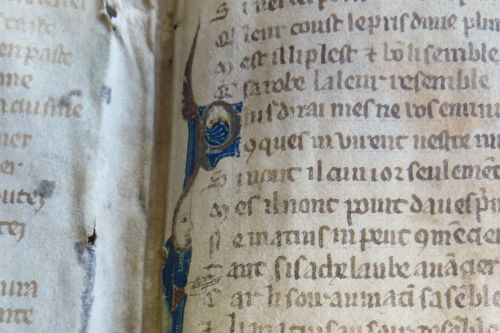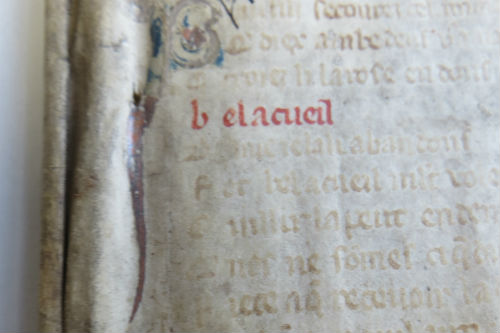Le Roman de la Rose or The Romance of the Rose – famously translated and adapted by Geoffrey Chaucer, author of The Canterbury Tales, a century later – is a medieval French poem styled as an allegorical dream vision.
Written by two authors in the 1200s, completed by 1280, in medieval French and weighing in at a hefty 22,000 lines, it describes the attempts of a courtier to woo his beloved.
The hand-written parchment fragments, from the archives of the Diocese of Worcester, were discovered by chance in the vaults of Worcester Record Office by Professor Nicholas Vincent from the University of East Anglia who asked Professor Marianne Ailes from the University of Bristol’s Centre for Medieval Studies and Department of French to help identify them.
Professor Ailes said: “Le Roman de la Rose really was the blockbuster of its day. We know how popular it was from the number of surviving manuscripts and fragments, a picture our fragment adds to, and from the number of allusions to the text in other medieval writings.
“The fragments I examined were not in great condition as the double sheet was probably used as a folder or binding for other documents.
“This was very common at the time as parchment was expensive and very durable, so ideal for recycling for incidental purposes such as bindings or folders.
“As soon as I saw the pages, I instantly recognised the allegorical name of ‘bel accueil’ – fair welcome - from Le Roman de la Rose and realised that we had something very special and unique on our hands. I also could hardly believe how early the handwriting looked.
“They looked too early for the text they contain, something which was confirmed by Professor Emeritus Ian Short of Birkbeck, University of London, a specialist in medieval handwriting.”
What is particularly interesting is that the specific pages found are the conclusion of the story which describe a sexual encounter between the two main characters, the lover and the rose, including some lines from the end of the poem missing from the manuscript used for the standard modern edition by French publishing house, Livre de poche.
An early translation by the Victorian medievalist FS Ellis in 1900 refused to translate this section of the text but included it in Old French as an appendix noting that he ‘believes that those who will read them will allow that he is justified in leaving them in the obscurity of the original’.
At this point of the story, the lover is presenting himself a pilgrim before a reliquary, equipped with his ‘staff’ and ‘scrip’ - a pilgrim's pouch or bag; the staff is described as ‘stiff and strong’.
He talks of his past uses of his equipment, of ‘sticking it into those ditches’ and kneeling before the relic ‘full of agility and vigour, between the two fair pillars...consumed with desire to worship’.
Professor Ailes added: “The Roman de la Rose was at the centre of a late medieval row between intellectuals about the status of women, so we have the possibility that these specific pages were taken out of their original bindings and recycled by someone who was offended by these scenes.”
Since identifying these fragments Professor Ailes has been asked to look at some other fragments of Old French recovered from a binding and held in Dundee City Archive.
These were of the French epic poem, Fierabras which was composed around 1200. The story of Fierabras concerns the legendary emperor Charlemagne and was translated into most medieval European languages.
Professor Ailes added: “Such fragments tend to be recovered from legal and similar documents and held in the kind of archives literary scholars will rarely need to consult.
“This find was the result of an academic in another discipline asking me to identify a text, demonstrating how crucial it is for academics to work collaboratively and across the disciplines.
“No two copies of a text in manuscript are ever identical so each new find adds another piece to a jigsaw which helps us understand how these texts were read and re-interpreted in the Middle Ages.”


